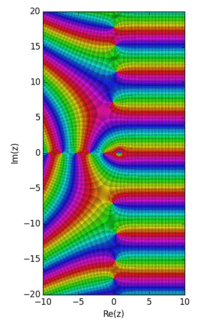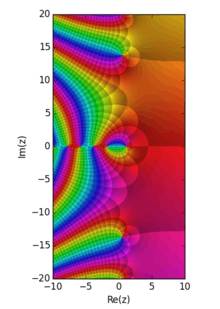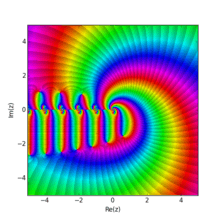Hurwitz zeta function
In mathematics, the Hurwitz zeta function, named after Adolf Hurwitz, is one of the many zeta functions. It is formally defined for complex arguments s with Re(s) > 1 and q with Re(q) > 0 by
This series is absolutely convergent for the given values of s and q and can be extended to a meromorphic function defined for all s≠1. The Riemann zeta function is ζ(s,1).

Analytic continuation

If the Hurwitz zeta function can be defined by the equation
where the contour is a loop around the negative real axis. This provides an analytic continuation of .
The Hurwitz zeta function can be extended by analytic continuation to a meromorphic function defined for all complex numbers with . At it has a simple pole with residue . The constant term is given by
where is the Gamma function and is the digamma function.
Series representation

A convergent Newton series representation defined for (real) q > 0 and any complex s ≠ 1 was given by Helmut Hasse in 1930:[2]
This series converges uniformly on compact subsets of the s-plane to an entire function. The inner sum may be understood to be the nth forward difference of ; that is,
where Δ is the forward difference operator. Thus, one may write
Integral representation
The function has an integral representation in terms of the Mellin transform as
for and
Hurwitz's formula
Hurwitz's formula is the theorem that
where
is a representation of the zeta that is valid for and s > 1. Here, is the polylogarithm.
Functional equation
The functional equation relates values of the zeta on the left- and right-hand sides of the complex plane. For integers ,
holds for all values of s.
Taylor series
The derivative of the zeta in the second argument is a shift:
Thus, the Taylor series has the distinctly umbral form:
Alternatively,
with .[3]
Closely related is the Stark–Keiper formula:
which holds for integer N and arbitrary s. See also Faulhaber's formula for a similar relation on finite sums of powers of integers.
Laurent series
The Laurent series expansion can be used to define Stieltjes constants that occur in the series
Specifically and .
Fourier transform
The discrete Fourier transform of the Hurwitz zeta function with respect to the order s is the Legendre chi function.
Relation to Bernoulli polynomials
The function defined above generalizes the Bernoulli polynomials:
where denotes the real part of z. Alternately,
In particular, the relation holds for and one has
Relation to Jacobi theta function
If is the Jacobi theta function, then
holds for and z complex, but not an integer. For z=n an integer, this simplifies to
where ζ here is the Riemann zeta function. Note that this latter form is the functional equation for the Riemann zeta function, as originally given by Riemann. The distinction based on z being an integer or not accounts for the fact that the Jacobi theta function converges to the Dirac delta function in z as .
Relation to Dirichlet L-functions
At rational arguments the Hurwitz zeta function may be expressed as a linear combination of Dirichlet L-functions and vice versa: The Hurwitz zeta function coincides with Riemann's zeta function ζ(s) when q = 1, when q = 1/2 it is equal to (2s−1)ζ(s),[4] and if q = n/k with k > 2, (n,k) > 1 and 0 < n < k, then[5]
the sum running over all Dirichlet characters mod k. In the opposite direction we have the linear combination[4]
There is also the multiplication theorem
of which a useful generalization is the distribution relation[6]
(This last form is valid whenever q a natural number and 1 − qa is not.)
Zeros
If q=1 the Hurwitz zeta function reduces to the Riemann zeta function itself; if q=1/2 it reduces to the Riemann zeta function multiplied by a simple function of the complex argument s (vide supra), leading in each case to the difficult study of the zeros of Riemann's zeta function. In particular, there will be no zeros with real part greater than or equal to 1. However, if 0<q<1 and q≠1/2, then there are zeros of Hurwitz's zeta function in the strip 1<Re(s)<1+ε for any positive real number ε. This was proved by Davenport and Heilbronn for rational and non-algebraic irrational q,[7] and by Cassels for algebraic irrational q.[4][8]
Rational values
The Hurwitz zeta function occurs in a number of striking identities at rational values.[9] In particular, values in terms of the Euler polynomials :
and
One also has
which holds for . Here, the and are defined by means of the Legendre chi function as
and
For integer values of ν, these may be expressed in terms of the Euler polynomials. These relations may be derived by employing the functional equation together with Hurwitz's formula, given above.
Applications
Hurwitz's zeta function occurs in a variety of disciplines. Most commonly, it occurs in number theory, where its theory is the deepest and most developed. However, it also occurs in the study of fractals and dynamical systems. In applied statistics, it occurs in Zipf's law and the Zipf–Mandelbrot law. In particle physics, it occurs in a formula by Julian Schwinger,[10] giving an exact result for the pair production rate of a Dirac electron in a uniform electric field.
Special cases and generalizations
The Hurwitz zeta function with a positive integer m is related to the polygamma function:
For negative integer −n the values are related to the Bernoulli polynomials:[11]
The Barnes zeta function generalizes the Hurwitz zeta function.
The Lerch transcendent generalizes the Hurwitz zeta:
and thus
- where
Notes
- ↑ http://nbviewer.ipython.org/github/empet/Math/blob/master/DomainColoring.ipynb
- ↑ Hasse, Helmut (1930), "Ein Summierungsverfahren für die Riemannsche ζ-Reihe", Mathematische Zeitschrift, 32 (1): 458–464, doi:10.1007/BF01194645, Zbl 56.0894.03
- ↑ Vepstas, Linas (2007). "An efficient algorithm for accelerating the convergence of oscillatory series, useful for computing the polylogarithm and Hurwitz zeta functions". arXiv:math/0702243
 .
. - 1 2 3 Davenport (1967) p.73
- ↑ Lowry, David. "Hurwitz Zeta is a sum of Dirichlet L functions, and vice-versa". mixedmath. Retrieved 8 February 2013.
- ↑ Kubert, Daniel S.; Lang, Serge (1981). Modular Units. Grundlehren der Mathematischen Wissenschaften. 244. Springer-Verlag. p. 13. ISBN 0-387-90517-0. Zbl 0492.12002.
- ↑ Davenport, H. & Heilbronn, H. (1936), "On the zeros of certain Dirichlet series", Journal of the London Mathematical Society, 11 (3): 181–185, doi:10.1112/jlms/s1-11.3.181, Zbl 0014.21601
- ↑ Cassels, J. W. S. (1961), "Footnote to a note of Davenport and Heilbronn", Journal of the London Mathematical Society, 36 (1): 177–184, doi:10.1112/jlms/s1-36.1.177, Zbl 0097.03403
- ↑ Given by Cvijović, Djurdje & Klinowski, Jacek (1999), "Values of the Legendre chi and Hurwitz zeta functions at rational arguments", Mathematics of Computation, 68 (228): 1623–1630, Bibcode:1999MaCom..68.1623C, doi:10.1090/S0025-5718-99-01091-1
- ↑ Schwinger, J. (1951), "On gauge invariance and vacuum polarization", Physical Review, 82 (5): 664–679, Bibcode:1951PhRv...82..664S, doi:10.1103/PhysRev.82.664
- ↑ Apostol (1976) p.264
References
- Apostol, T. M. (2010), "Hurwitz zeta function", in Olver, Frank W. J.; Lozier, Daniel M.; Boisvert, Ronald F.; Clark, Charles W., NIST Handbook of Mathematical Functions, Cambridge University Press, ISBN 978-0521192255, MR 2723248
- See chapter 12 of Apostol, Tom M. (1976), Introduction to analytic number theory, Undergraduate Texts in Mathematics, New York-Heidelberg: Springer-Verlag, ISBN 978-0-387-90163-3, MR 0434929, Zbl 0335.10001
- Milton Abramowitz and Irene A. Stegun, Handbook of Mathematical Functions, (1964) Dover Publications, New York. ISBN 0-486-61272-4. (See Paragraph 6.4.10 for relationship to polygamma function.)
- Davenport, Harold (1967). Multiplicative number theory. Lectures in advanced mathematics. 1. Chicago: Markham. Zbl 0159.06303.
- Miller, Jeff; Adamchik, Victor S. (1998). "Derivatives of the Hurwitz Zeta Function for Rational Arguments". Journal of Computational and Applied Mathematics. 100: 201–206. doi:10.1016/S0377-0427(98)00193-9.
- Vepstas, Linas. "The Bernoulli Operator, the Gauss–Kuzmin–Wirsing Operator, and the Riemann Zeta" (PDF).
- Mező, István; Dil, Ayhan (2010). "Hyperharmonic series involving Hurwitz zeta function". Journal of Number Theory. 130 (2): 360–369. doi:10.1016/j.jnt.2009.08.005.
External links
- Jonathan Sondow and Eric W. Weisstein. "Hurwitz Zeta Function". MathWorld.